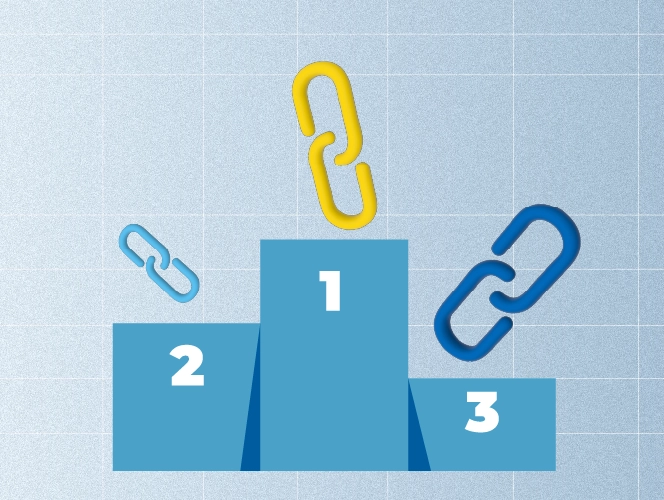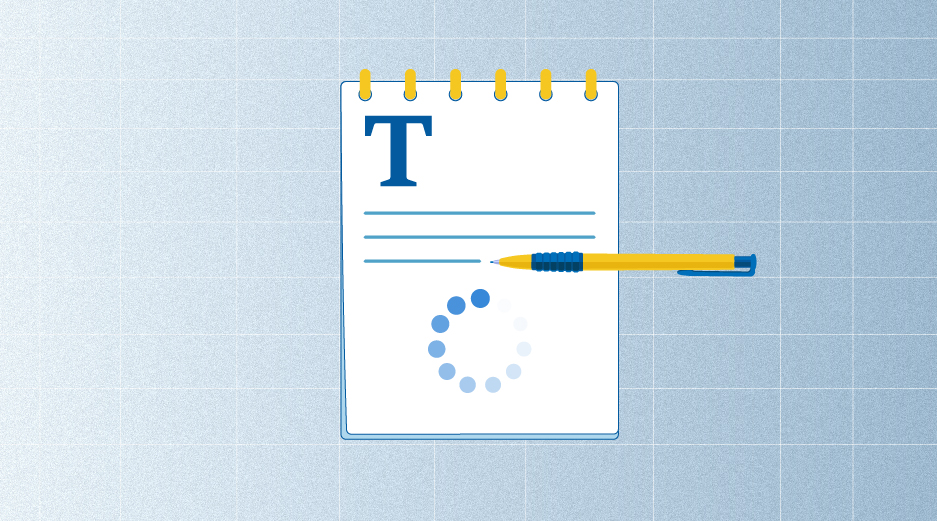Building a great website with outstanding content is an ongoing process and a journey without a finish line. Outstanding content is something you should never compromise on. In fact, research has shown that 81% of marketers consider content as a core business strategy.
However, here is the interesting part.
Even if you can be proud of your website’s unique and insightful content, you shouldn’t consider your work complete. There’s always something missing or something that can be better, and that’s where finding and fixing the content gap comes in.
But let’s start by understanding what it is, anyway․
What Is Content Gap?
A content gap refers to topics you don’t cover or don’t present properly on your website but your competitors have covered.
To explore more SEO terms, read our SEO glossary and enrich your knowledge.
Identifying and filling this gap will help you successfully optimize your content and deliver value to your website readers. As a great bonus, you will boost your website’s SEO performance too.
Common Types of Content Gaps
One of the first things you should do before analyzing the content gap is to understand what types it has. Here are some main ones you should know.
- Relevancy
When doing analysis, look for any new or current topics you might be missing. Keep an eye on the trends to ensure your content remains relevant. A content refresh can be an effective way to address these gaps, ensuring your material stays relevant and up-to-date with trends.
- Thoroughness
While identifying content gaps, check whether your articles lack depth and discover how to make them more comprehensive. Later, you can add new sections to your articles and add internal links to connect them with existing content.
- Readability
Imagine a case when people check your website and have a hard time reading your articles. This is something you should avoid at any cost. When trying to find any gaps in your content strategy, don’t forget to monitor whether your articles are easy to read or not. Check if they are well organized, have clear, descriptive headings, and are free from keyword stuffing that can make the text feel unnatural.
- Format
This type of gap happens when you don’t suggest content on your website in a format your audience likes. Maybe you can make your articles more engaging and interactive by adding images or infographics. Or you may create new sections on your website, like video tutorials, podcasts, webinars, or product demos, to meet your website visitors’ preferences.
- Expertise
Search engines “help” your content rank, and people consider it a reliable source only if your content is based on authoritative sources. So, your articles may not perform well in search engines because they lack expert insights and perspective. Find and fill this gap to add extra credibility to your website.
Finally, check whether your content presents your own experience too. If not, you have to add your unique insights and perspectives on the topic to make your content more valuable.
Why Should You Analyze the Content Gap?
Finding the content gap can take time and resources, so you might wonder if it’s worth it. The short answer is yes.
Let’s take a closer look at the benefits of analyzing the content gap.
- Adding relevance to your content: You should always stay on top of the latest industry trends and hottest topics. By finding and filling gaps in your content strategy, you can keep it fresh and up-to-date.
- Boosting your website’s SEO rankings: Our ultimate goal is to have a website that has higher rankings in search engines, isn’t it? SEO content gap analysis can help identify missed opportunities for attracting organic traffic and improve your website’s SEO performance.
- Effectively managing resources: You put a lot of time and effort into your content marketing strategies. Competitive content analysis helps make sure your efforts are well-focused and will produce great results.
- Making your website more authoritative: If you manage to spot and address content gaps, you give extra authority and credibility to your website positioning it as a reliable source in the industry.
- Outranking your competitors: One of your main goals is to outperform your competitors, isn’t it? By finding and filling gaps in your content strategy, you can offer something to your website readers that your competitors don’t. This is your opportunity to outrank them.
Okay, now it’s clear as day that you should invest in competitive content analysis. Let’s go over the best ways to do it effectively.
Content Gap Best Practices
How to do a content gap analysis successfully? This is a question you might ask, especially if it’s your first time doing it. Hopefully, these tactics may help you.
- Find your competitors and analyze their strategies
The very first thing you should do is identify your organic competitors. There are several SEO tools that you can help at this stage. The next thing you should do is check their websites and top-ranking content to identify new opportunities for boosting your website’s visibility.
- Audit your content
After analyzing your competitor’s websites, check your own website. Find out what topics your competitors cover and what keywords they target but you don’t. Another step you can take is to discover how you can refresh and update your old content. Check how relevant and accurate your old content is. Remove outdated information and add new statistics and insights. When auditing a website, also pay attention to how optimized your content is. Check for duplicate content and keyword cannibalization issues.
- Create your content plan
After doing your research, you need to create a content plan that will be your roadmap for optimizing your content. You might find new, high-performing keywords you haven’t targeted yet, so you can create new content. Or, you could update your old content by adding new sections or including secondary keywords. As part of this process, don’t forget the importance of crafting catchy blog titles that grab attention and encourage clicks. This way you will ensure your content performs well and has high visibility.
Now, let’s finally discuss how you can identify content gaps using specific tools.
Analyze the Content Gap: 4 Steps With Ahrefs
It’s almost impossible to imagine an SEO specialist or a content marketer working without Ahrefs. This all-in-one SEO tool is also great for competitive content analysis.
Here’s how Ahrefs can help you in this process.
Step 1: Use Competitive Analysis Feature
An Ahrefs study has found that 94.74% of keywords get 10 monthly searches and only 0.0008% of keywords get more than 100k searches per month. So, it’s really important to find keywords with strong SEO potential.
Ahrefs can be your friend at this stage and help you reach that goal. Not only that, with its Competitive Analysis feature, you can find content gaps and outperform your competitors. Just follow these steps:
Step 1: Go to your Ahrefs account.
Step 2: Go to the Competitive Analysis tool and ensure it’s set to Keywords.
Step 3: Next, add your domain in the first field and 1-3 competitor domains below.
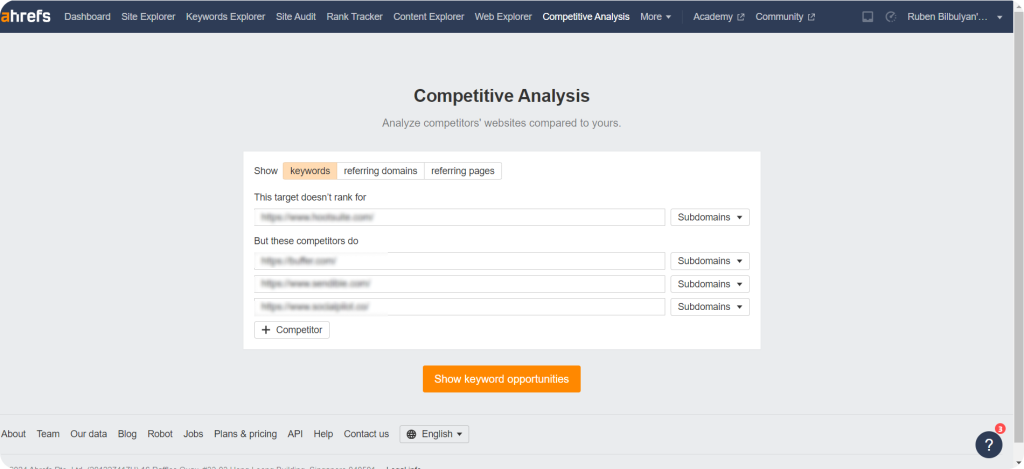
Step 4: Click the Show keyword opportunities tab to find all the keywords your competitors rank for, but you don’t.
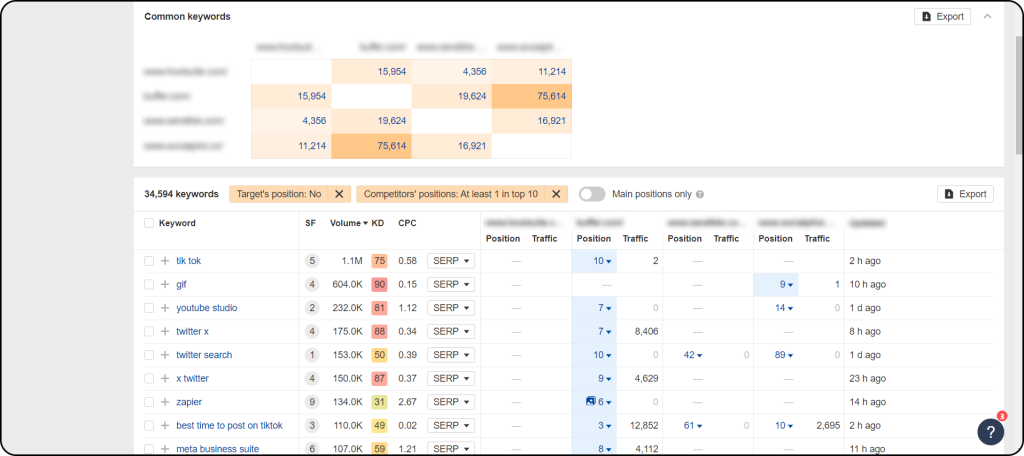
Collecting Ahrefs keywords gap data opens excellent opportunities to create new content or optimize existing content. But first, you need to ensure this data is clean. This takes us to the next point.
Step 2: Clean and Export Data
Data is a goldmine. However, not all the data you collect is worth your attention. So, you need a clean content gap report from the Ahrefs Content Gap tool.
Here are the steps you can take:
- Leave out your competitors’ brand names.
- Low-volume keywords don’t add any value to your content strategy, so you can also exclude them by filtering for keywords with minimal search volume.
- Use a Keyword Difficulty (KD) filter to discover keywords that can bring more traffic to your website. Choose the maximum KD to be 30.
- Lastly, when monitoring several competitors, update their positions to show at least two sites in the top 10.
After setting all these filters and getting important data, you can export the data to CSV files.
Check out our quick video tutorial on how you can get a content gap overview with Ahrefs.
Step 3: Use Ahrefs Content Gap Analysis Template
You have all the valuable data collected from the Ahrefs content gap tool in your hands. But how to manage it effectively? Luckily, Ahrefs offers a content gap template as well. So you can import all data collected from Ahrefs there by taking these steps.
- When analyzing the content gap, export filtered data.
- Make a copy of the gap analysis template.
- Go to the Data tab.
- Click Import, then Upload, and Choose your Ahrefs data.
- Lastly, click on Append to the current sheet.
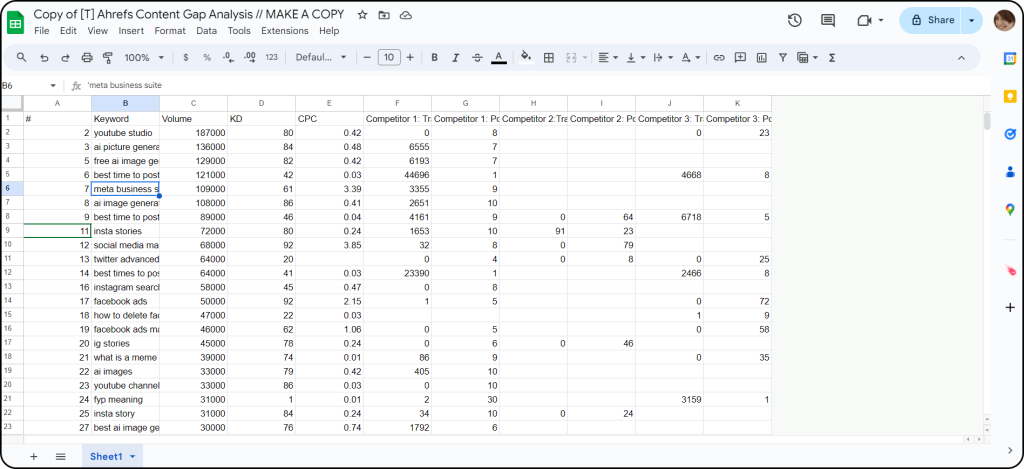
Ok, now you have created a template as well, it’s time to monitor the gathered data.
Step 4: Analyze the Data
Your job is to find relevant keywords that your competitors rank for. Those keywords should have a good keyword balance, such as relatively low keyword difficulty but high search volume and traffic potential. When analyzing, it’s essential to also consider long tail vs short tail keywords, as each can offer different advantages in targeting the right audience.
During this process, you must filter your keyword list and find keywords with really good SEO metrics. These highlighted keywords have low difficulty and high search volume and traffic potential, so you should consider creating content around them.
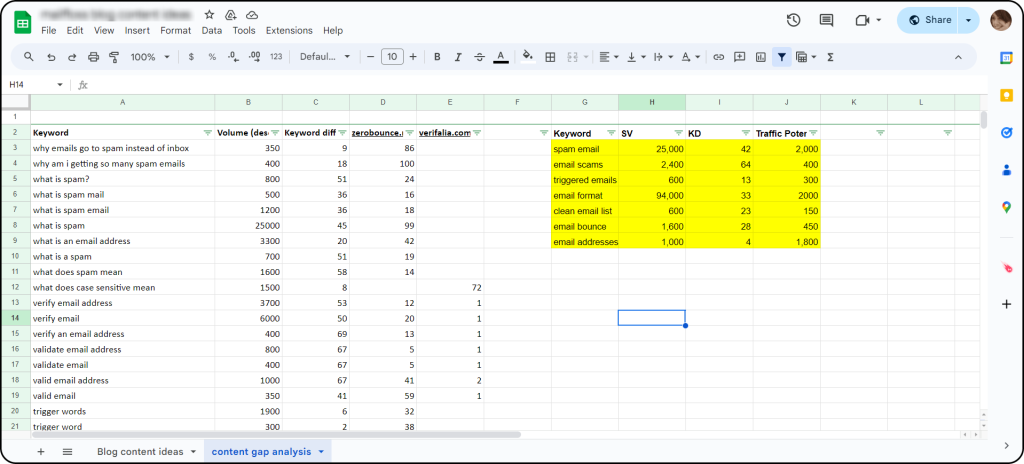
Don’t hesitate to audit your content and find out whether your website already targets these keywords. If not, you must create new articles focused on those topics and target the missing keywords.
If you already have content around those topics, you can optimize it by adding new sections to target missing keywords as well. Incorporate different keyword types for SEO as well to boost your content’s reach.
Analyze the Content Gap: 3 Steps With SEMrush
To make your competitive gap analysis process even better and successfully fill those gaps you must use SEMrush too. This is how you can do that.
One of the first things you should do is choosing your main competitors.
SEMrush is here to help you, so take these steps:
Step 1: Go to your SEMrush account.
Step 2: Navigate to the Organic Research tool.
Step 3: Enter your domain and click Search.
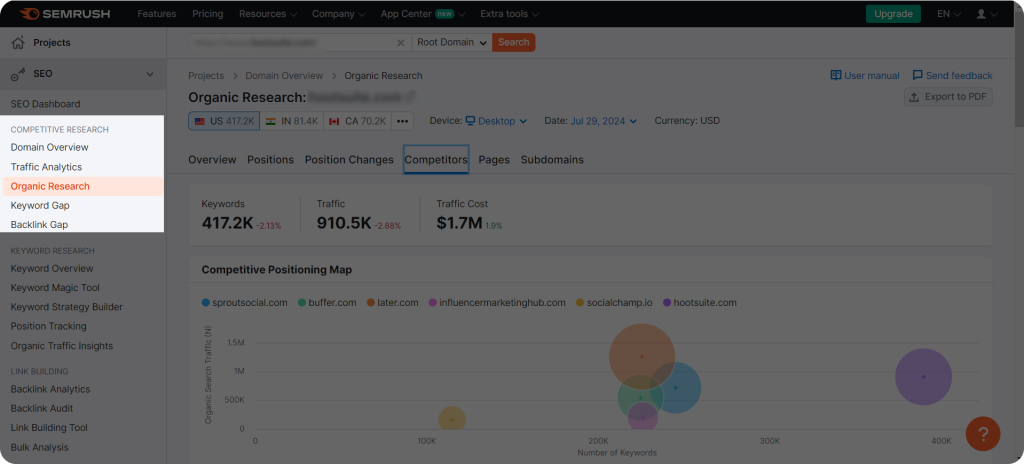
Step 4: After getting the report, click Competitors and collect a list of your main competitors.
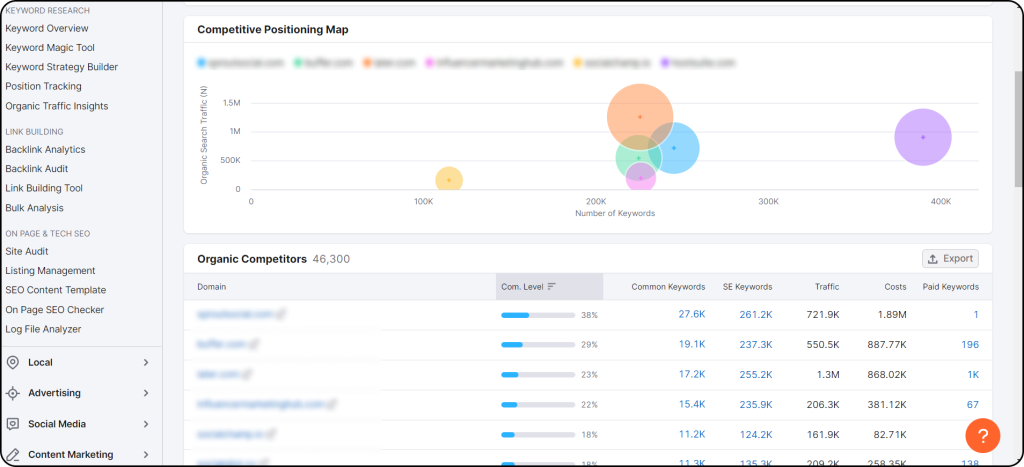
You already know which websites you need to outrank. Next, you should learn how to do keyword gap analysis with SEMrush.
Step 2: Discover Keyword Gaps
SEMrush huge and accurate database is great for finding the keywords gap as well. All you need to take these steps:
Step 1: Go to the Keyword Gap tool.
Step 2: Enter your domain.
Step 3: Add up to four competitors’ domains.
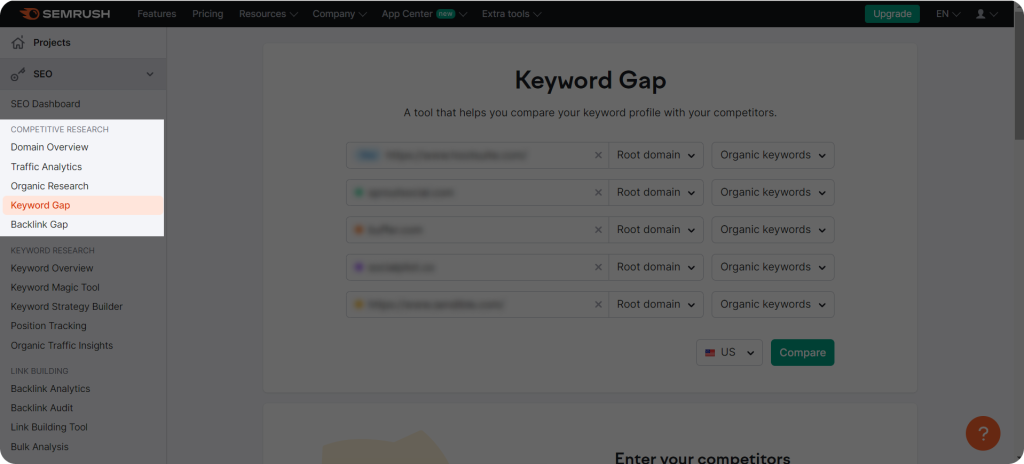
Step 4: Then, choose your location and click Compare.
Step 5: You will see a report about keyword overlap, which shows keywords you and your competitors have in common.
Step 6: Explore the Top Opportunities section and press the Missing tab to get a list of keywords for which all your competitors rank but you don’t. On the other hand, the Weak tab shows your target keywords for which competitors are already ranking.
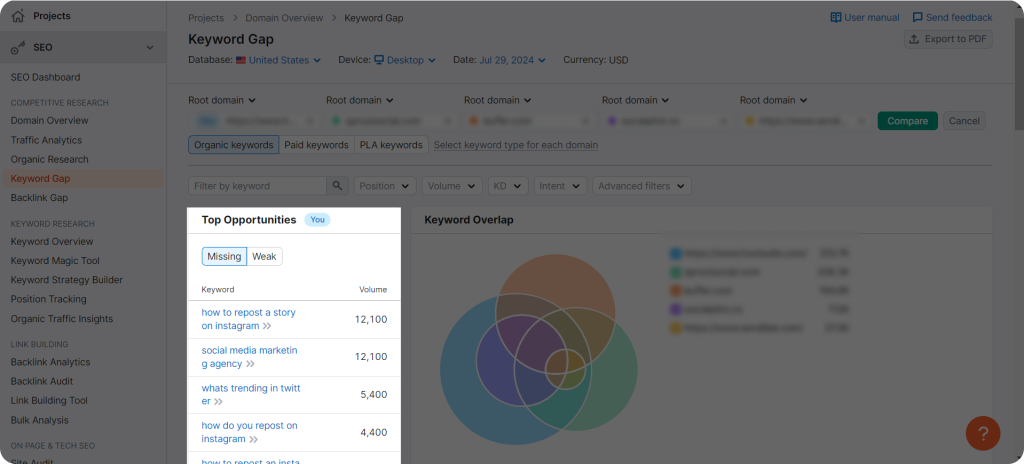
After this, you should create new content around missing keywords or optimize the ones where your competitors’ content ranks higher. However, before doing that, you should analyze those keywords.
Step 3: Analyze and Segment Your Keyword Gaps
Remember that we highlight the importance of finding the right data. There are several filters you can use to find the most essential and relevant data for your needs.
Use the Position filter to focus on keywords for which your competitors rank in the top 10 results. Utilize the Keyword Difficulty filter to identify keywords with low difficulty scores and high potential for ranking.
Don’t forget to use the Add to keyword list button to save all important keywords you will use later.
Finally, you need to press the Export button and save data in Excel, CSV, or another format you like.
Analyze the Content Gap: 3 Steps With Moz
One of the best alternatives to SEMrush and Ahrefs is Moz, and this tool can be extremely helpful for analyzing content gap, too.
We will go step by step through how you can effectively use Moz to define content gaps.
Step 1: Discover Who Your Competitors Are
The first thing you should do is identify your main competitors. The Moz True Competitor tool can help you in that process. Here is how:
Step 1: Enter your Moz account and navigate the True Competitor tool.
Step 2: Add your domain and choose a preferred location.
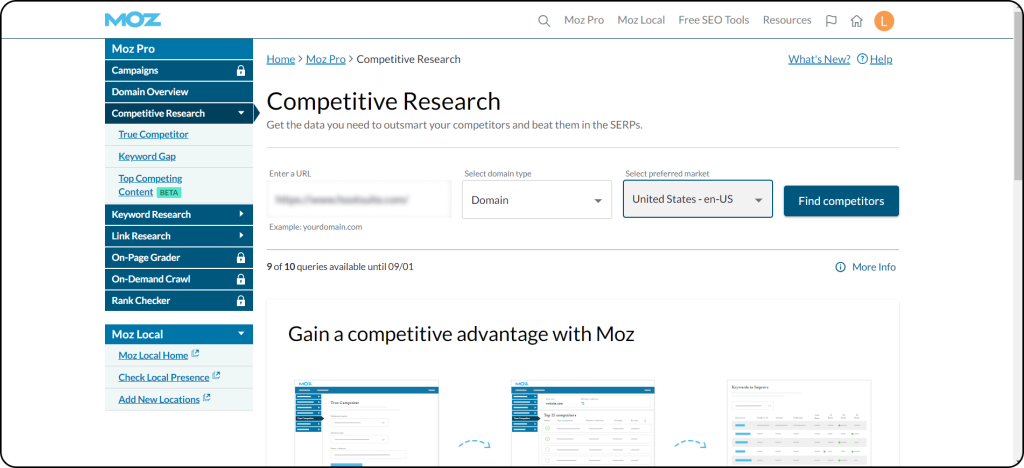
Step 3: Click on Find competitors and get a list of your top 25 competitors.
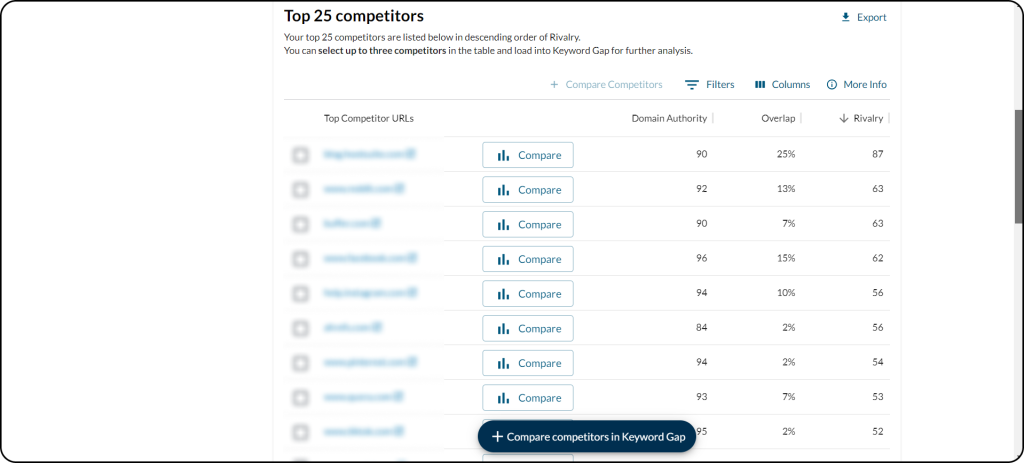
Now, you collected data about our competitors thanks to Moz. Maybe you have already noticed the pattern. After finding the main competitors, the next step is discovering the keywords gap.
Step 2: Define Keyword Gaps
Moz has a Keyword Explorer tool that can be highly beneficial when you are trying to find ways to do keyword gap analysis. The first thing you can do is find competitors’ top keywords.
Step 1: Enter your Moz account and go to the Keyword Explorer tool.
Step 2: Choose the Root domain filter.
Step 3: Enter your website’s URL.
Step 4: Add the URLs of your two competitors’ websites.
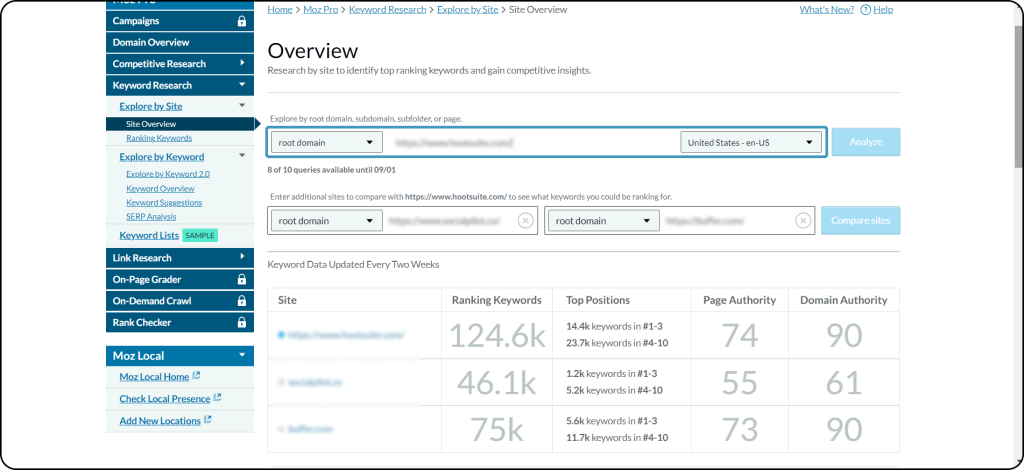
Step 5: Click the Analyze button to obtain data on the top-ranking keywords for your competitors’ websites.
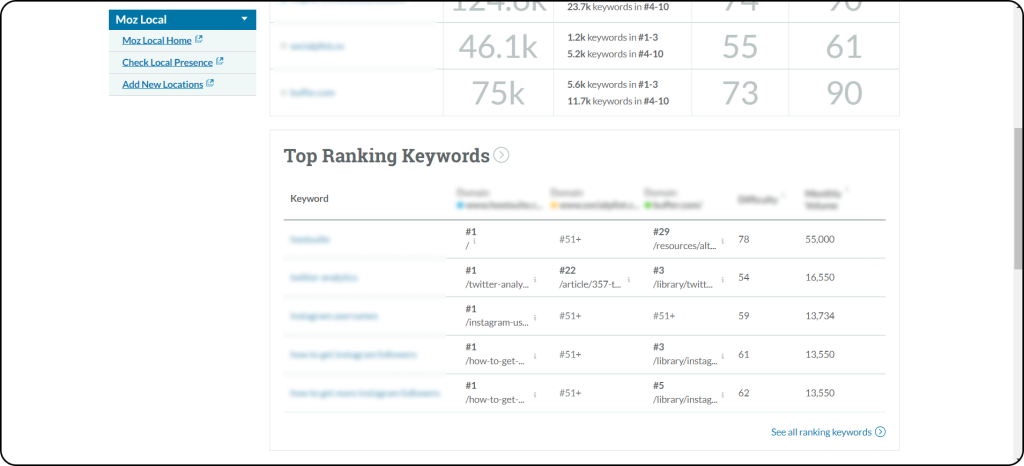
There’s even more to it. Moz Keyword Explorer allows you to define keyword overlap and discover terms you can successfully rank for.
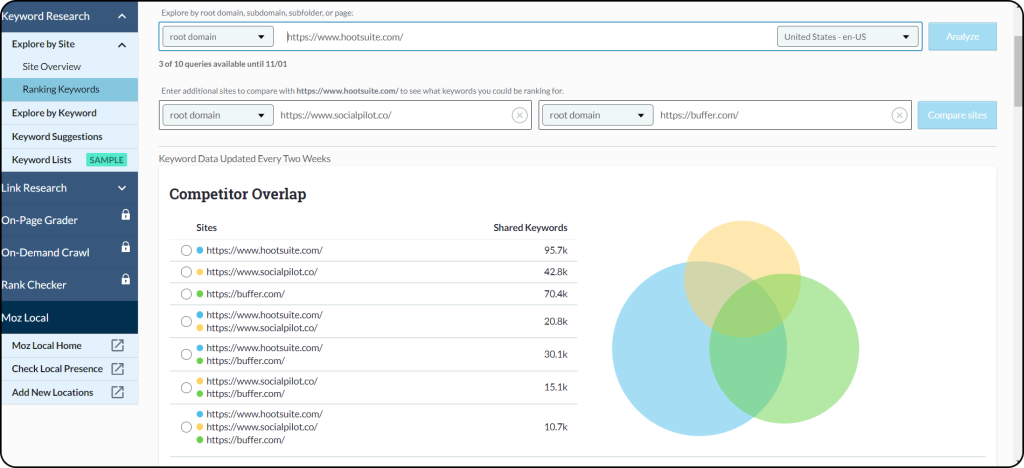
However, you need to filter the data by difficulty and search volume for each keyword to find ones that have a good balance between competition and potential traffic.
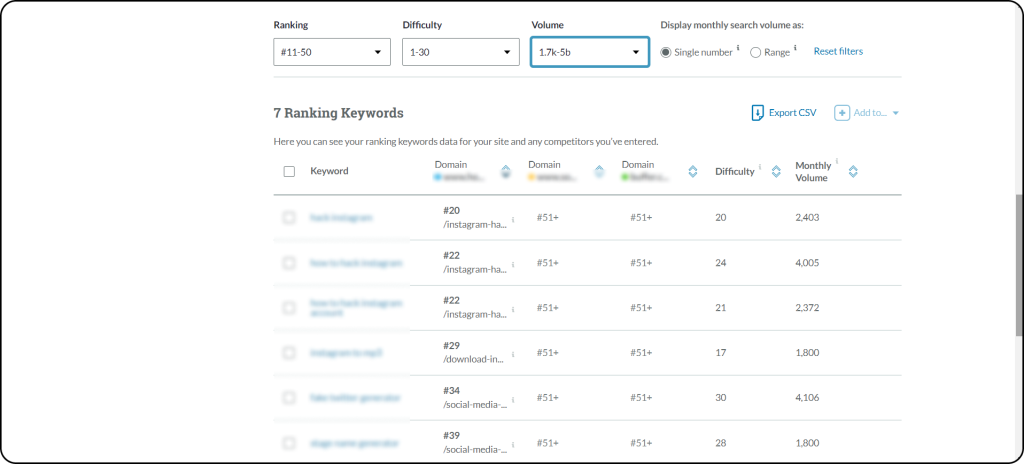
To smartly use all this data, you need to segment and categorize them.
Step 3: Group Your Keywords With Moz
Imagine you have collected many missing keywords to add to your content plan. You should categorize them to keep things clear and organized. If you think this is a daunting task because you need to do it manually, don’t worry because the Moz Pro Keyword Suggestions section lets you group keywords based on their lexical similarity.
Follow these steps to do it:
Step 1: Navigate to the Keyword Suggestions section.
Step 2: Add your keyword and click Analyze.
Step 3: Find the Group by lexical similarity part and choose the level (we have selected medium).
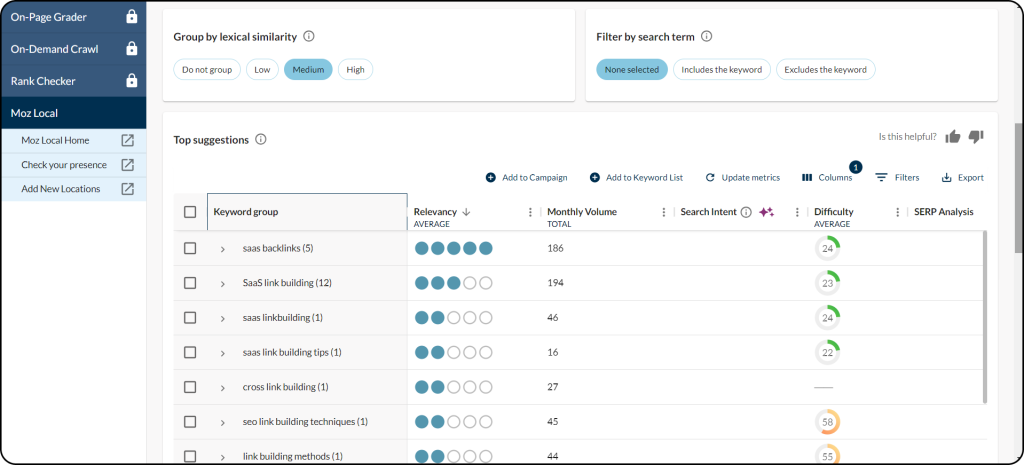
To get a better visual, we’ve also made a short video tutorial on how you can complete the content gap with Moz.
Thanks to this process, you can make your future content planning accurate and structured.
How Often Should I Analyze the Content Gap?
You should do this analysis on a quarterly basis. This is the ideal option.
However, several factors influence how often you should conduct a gap analysis: competitiveness, your industry, and how often you update your content. I
In any case, you should regularly conduct this process to keep up with marketing changes and trends. It will also help you keep the pulse on customers’ needs and ultimately gain a competitive advantage.
Key Takeaways
- Analyzing the content gap helps to boost your content’s visibility, increase your SEO efforts, and gain a competitive edge.
- There are several types of content gaps you must examine, such as relevance, depth, and engagement of your content.
- To make the gap analysis process more efficient, identify your competitors, audit your content, and create a content plan.
- When doing SEO content gap checkup with Ahrefs, start defining keyword gaps and export and analyze data.
- Use SEMrush to identify your organic competitors, then find and monitor your keyword gap.
- If your preferred tool is Moz, start finding your main competitors and find new keyword opportunities.
FAQ about content gap
What are the best tools for content gap analysis?
Some of the best tools for finding the content gap are Ahrefs, Semrush and Moz.
What is keyword gap vs content gap?
Keyword gap analysis identifies keywords your competitors rank for and you don’t, while a competitive content analysis uncovers content topics you don’t.
When can you expect to see results from a content gap checkup?
You can expect to see results within a few weeks to a few months, depending on the complexity of your content and how detailed this process is.

Quiz Time
Let's put your knowledge to the test.
Leave your email below to get a SayNine certificate!
Are you sure?



